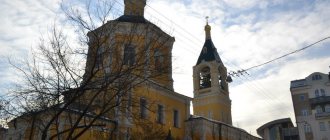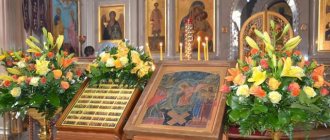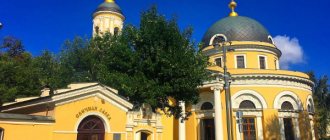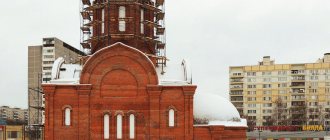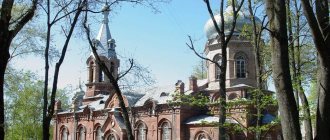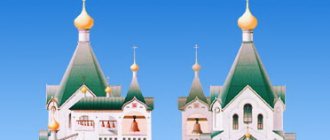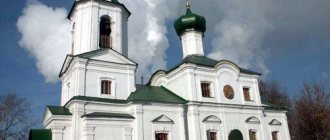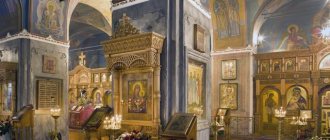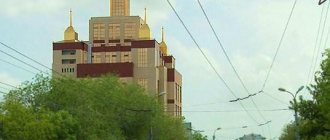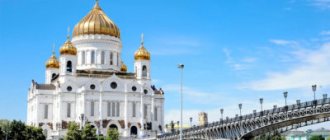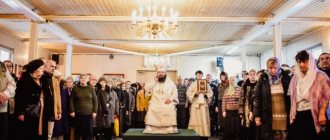| Moscow All Saints Church on Kulishki, 2006. Photo by Mikhail Chuprinin from the site sobory.ru |
Moscow Church in honor of All Saints on Kulishki
, metochion of the Alexandrian Orthodox Church
- Address: Russia, 109074, Moscow, Slavyanskaya Square, 2. Metro “Kitay-Gorod”
- Telephone. Fax
- Official site:
- On the map: Yandex.Map, Google map
According to legend, the temple was built by Grand Duke Dimitri Donskoy: having returned victorious from the Battle of Kulikovo in 1380, he immediately ordered the construction of a temple in memory of the Russian soldiers who died on the battlefield.
However, there is another version of historians, according to which the temple appeared on this site long before 1380. Sometimes the exact date is given - around 1367, that is, also during the reign of Donskoy, only much earlier than the Battle of Kulikovo. And the original foundation of the temple here is associated with the development and settlement of this area near the Moscow suburb. It is believed that in ancient times this place was inconvenient and unsuitable for settlement, as evidenced by its very name - “Kulishki” or “Kulizhki”, which is still a mystery for historians and Muscovites. One interpretation of the word “kulishki” defines it as a marshy, swampy place, or a wetland. There is a legend that once upon a time there really was a swamp here, where waders lived - birds that live in swampy areas. It is known that in ancient times the Kulishki area had large borders and extended higher - to Ivanovskaya Gorka and beyond. Scientists believe that at the dawn of Moscow history there was a dense forest here, and therefore “kulishki” can mean cleared areas of land or cleared clearings among the forest. One of the local churches in the name of John the Baptist was then called “that under the forest.” In the 15th century, this forest was replaced by the luxurious Sovereign Gardens, which left a memory in the name of Starosadsky Lane adjacent to Kulishki. Also, kulizhki (kuligami) in the Old Russian language were the names of plots of land along the banks of rivers, near bends, which were used for haymaking. There is an opinion that “kulishki” comes from the word “kulki” or “purses” - they have been abundant here for a long time, which is why the neighboring area, now known as the Yauz Gate, was called Kosheli in the old days. Finally, the most unconvincing, but historically justified version of the meaning of the word “kulishki” dates its origin to the times of Dmitry Donskoy himself and the Battle of Kulikovo. From the name of the area where the glorious battle of the Russian army took place - the Kulikovo Field - the name of the Moscow Kulishki came from, since the Grand Duke passed here twice with his army - going from the Kremlin to the battle and returning to Moscow with victory. Then he ordered to build a wooden church here in the name of All Saints in memory of the fallen Russian soldiers and to call this area “Kulishki” in honor of the Battle of Kulikovo.
The Kulishki area has been reliably known since the 14th century, but it began to be developed long before the Battle of Kulikovo. At that time, this area was already adjacent to the Moscow suburb, which extended from the eastern wall of the Kremlin and Red Square. Hence the opinion of historians that the first church stood here since ancient times, when the first settlements appeared in Kulishki. For a few local residents, it could have been an ordinary parish church. And in 1380, Prince Dmitry Donskoy ordered it to be restored or rebuilt in honor of the victory and the slain soldiers - as a memorial temple.
Written sources mention the All Saints Church since 1488, and on a very sad occasion. When describing the strongest fire in Moscow, the chronicler writes: “...at the ninth hour of the day the Church of the Annunciation on the Swamp caught fire, and therefore it burned from the city to Kulishka, not far from All Saints...”.
The wooden temple burned repeatedly in fires in 1493 and 1547.
During the fighting in 1612, the temple was badly damaged. Next to him stood the cannons of the people's militia.
| Moscow All Saints Church on Kulishki, 1882. From Naydenov's album |
In the first half of the 17th century, the temple was a single-apse cubic volume, surrounded on three sides by a gallery on basements.
In 1662, a small Nikolsky chapel was added to its southeastern part. The chapel of the prophet Nahum, which previously existed at the temple, was located in the southern part of the main altar. After the fire of 1688, the damaged vault and the head of the quadrangle were rebuilt, the windows were cleared, and the refectory and bell tower were added. At the same time, the upper tier of the gallery was dismantled, and the lower one was included in the volume of the basement of the refectory part. After the fire of 1737, the remains of the gallery were laid down and the refectory was rebuilt. During the 17th-19th centuries, the temple was renovated several times. According to the Clergy Gazette of the 18th century, the church was described as follows: “Ivanovo forty (deanery) parish church in the name of All Saints, in Kulishki, stone, solid, with two chapels of St. Nicholas the Wonderworker and the Prophet Nahum, with sufficient utensils.”
In 1931 the temple was closed. The building was transferred to various institutions.
In the 1950s, the All Saints Church was renovated from the outside. In 1967, the construction and installation department was located inside the temple. In the 1970s, the temple was completely restored from the outside and in the 1970s-1980s it was given over to the Touring Bureau of the Mosconcert branch. Another restoration was carried out on the outside, which was completed by 1982. In 1990, the internal renovation of the temple was carried out and given to the Museum of History and Reconstruction of Moscow. Many fragments of paintings were revealed on the walls.
At the end of 1991, the temple was returned to the Church.
On April 24, 1999, the grand opening of the courtyard of the Alexandria Church took place at the All Saints Church.
In 2002-2003 The dilapidated building of the clergy house was completely renovated, lined with brickwork and covered with metal tiles. In 2004, from a two-story building located near the clergy house and a two-story building in disrepair, a wonderful two-story building of the bishop's house was built. In 2006, a new two-story building was built on the empty space of the church yard, and in 2008, it was successfully rebuilt; the first floor of which is the office part and the reception room of the metropolitan, and on the second floor there are rest rooms for the clergy of the metochion.
In 2007, the temple building was completely renovated from the outside, the facade was restored with partial replacement of the brickwork. The newly painted red-brick church building acquired its original, historically accurate white-red color scheme of the 17th century, and the domes and roof of the church were re-covered with copper sheets. In the same year, the asphalt surface of the courtyard around the temple was replaced with stone paving stones.
In 2009-2010, the limestone foundation, which had become damp over the years, was completely replaced with monolithic concrete installed on reinforced concrete tubular piles sunk into the ground by jacks. A monolithic reinforced concrete slab was placed under the first, lower tier of the temple, which over the years ended up underground. The technical basement was restored between the monolithic slab and the reinforced concrete foundation. Thus, it was possible to stop the formation of cracks in the load-bearing walls of the temple and prevent the possible destruction of the bell tower, which had leaned over time.
The existing building dates from the 16th century and may have incorporated parts of an earlier stone structure. On the western side of the All Saints Church, a cast-iron porch from the 19th century has been preserved. Over the centuries-long history of its existence, the All Saints Church sunk 3.5 meters into the ground and its bell tower tilted slightly, becoming another “Leaning Tower of Pisa” in Moscow.
History of All Saints Church
In the middle of the 14th century, the Moscow Principality became stronger. In 1374, Dmitry Ivanovich, the ruler of the state, refused to pay tribute to the Golden Horde and did not allow the Tatar protege Mikhail Alexandrovich to take the Vladimir throne. Dissatisfied with the willful vassal, Mamai, one of the leaders of the Horde, organizes a military campaign against Moscow.
Under the banner of the Moscow prince, his supporters and squads gather to repel the hated invaders. Dmitry Ivanovich visited Sergius of Radonezh, who blessed the Russian army for the upcoming battle. The holy monk sends the monks Peresvet and Oslyabya , placing a schema on them instead of a shield and helmet.
The battle between the Russian knights and the Tatar horde took place on September 8, 1380 on a field near the confluence of the Nepryadva River and the Don. The skillful and courageous actions of princes Dmitry Mikhailovich and Vladimir Andreevich, the appanage prince of Serpukhov, who received the nickname Brave after the Battle of Kulikovo, led to the defeat of the enemy army. Mamai left the battlefield with a small detachment.
The burial of the Russian soldiers killed on the Kulikovo Field continued for eight days. On the Feast of the Intercession of the Blessed Virgin Mary, the winning troops returned to Moscow. In the Andronikov Monastery, with a crowd of people and in the presence of Prince Dmitry Donskoy, Patriarch Cyprian celebrated the liturgy .
In memory of the great victory, Dmitry Ivanovich decided to erect a cathedral. The location for the construction was chosen long and carefully. Not far from the Kremlin, on the road leading to Vladimir, a temple was erected in honor of All Saints. South of the church, to the mouth of the Yauza River, stretched a meadow, popularly called the Kulizhkov Field. It is possible that the consonance of the names and the confluence of the Yauza River into the Moscow River served as the reason for choosing the location.
The first written mentions of the All Saints Church appear in 1488 in connection with a fire in Moscow. Twice more, in 1493 and 1547, the wooden building suffered from fire.
In the history of the “time of troubles” two events are connected with the temple on Kulishki. At that moment, when the body of the murdered False Dmitry was transported past the church to the “poor house,” as the cemetery for drunken or frozen Muscovites was called, a terrible wind rose. The storm tore the roof off the Barbarian Gate. The second time the temple was damaged in the fall of 1612 during a cannon attack on the Kremlin, which was occupied by Polish invaders and militia troops under the command of Dmitry Pozharsky.
Perhaps it is useful for everyone to know how a temple differs from a church and a cathedral.
In 1770, a plague epidemic broke out in Moscow. Crowds of townspeople sought to venerate the Bogolyubskaya Icon of the Mother of God, located at the Barbarian Gate not far from the Church of All Saints. The crowd of people contributed to the spread of the deadly disease. The rector of the temple, Archbishop Ambrose, banned the service of prayers in front of the holy image, which led to mass unrest, called the “plague riot.”
At the end of the sixteenth century, a large red brick stone building was built on the foundations of a wooden church. In the eighteenth century, minor reconstructions did not change the appearance of the temple . The interior walls were decorated with paintings, the iconostasis was updated, the floor was made of stone, and the size of the windows was increased.
During the fire of 1812, when Moscow was occupied by French troops, the premises were badly burned. It took almost twenty years to restore the structure. In 1842, by decree of the Moscow Spiritual Consistory, the image of the Mother of God “Bogolyubskaya” .
In the thirties of the last century, the Bolsheviks used the church building for the needs of state security agencies. The Moscow History Museum has owned the premises since 1975. In 1991, the All Saints Cathedral was returned to the Russian Orthodox Church. Since 1999, the temple on Kulishki has housed the status metochion of the Alexandrian Orthodox Church.
About the temple
The Church of All Saints, in Kulishki, was erected during the reign of the Grand Duke of Moscow Dmitry Ivanovich, named Donskoy, in memory of his victory on the Kulikovo field over the Tatar-Mongol army led by Mamai.
Before the Battle of Kulikovo, the prince turned for a blessing to the Trinity, to St. Sergius of Radonezh for the great battle with a formidable enemy.
The holy elder said to Demetrius: “...May God be your helper, you will defeat the enemy who dominates your state... His destruction awaits, and glory to you from the Lord.” Demetrius knelt down, and the Monk Sergius made the sign of the cross over him. The monk gave the prince two schema-monks as assistants - Alexander, nicknamed Peresvet, and Andrei, nicknamed Oslyabya, and ordered them to prepare, and instead of a perishable shield and helmet, the Monk Sergius placed a schema on them.
“The 8th day of September has arrived - the great feast of the Nativity of the Virgin Mary. It was a foggy morning. Having strengthened the regiments, the Grand Duke returned to his banner. And so the regiments moved forward. The leading regiment is led by Prince Dimitri Vsevolodovich and his brother, Prince Vladimir Vsevolodovich. And from the right hand the regiment is led by Nikolai Vasilyevich with the Kostroma residents, and from the left hand the regiment is led by Timofey Valuevich with the Kostroma residents. Many regiments of the Horde are wandering from all sides, from the multitude of troops there is no place for them. Mamai, having gone to a high place with three associates, observes the beginning of bloodshed.
Strong regiments were already approaching close to each other, and then the evil Pecheneg rode out, boasting of his valor to everyone. And Alexander Peresvet, a monk who was in Vladimir Vsevolodovich’s regiment, saw him, and stepped out of the ranks and said: “This man is looking for someone like himself, I want to talk to him.” And he had a kokol on his head, he was armed with a schema by order of Abbot Sergius. He rushed at the Pecheneg, saying: “Hegumen Sergius, help me with prayer!” And they struck hard with their spears, until the ground almost broke under them, and they both fell from their horses and died.
And both great forces came together menacingly, firmly fighting, cruelly destroying each other, and not only from weapons, but also from great crowding, under the horse’s hooves they gave up the ghost, for it was impossible to fit on that field of Kulikovo: that field was cramped between the Don and the Mecheya ..."
The battle is over. Mamai and the remnants of the army fled. Mountains of the dead rose everywhere. Those who survived were drawn to the grand ducal banner. When everyone gathered, they saw that the Grand Duke of Moscow Dimitri Ioannovich was not among them. He was found lying unconscious under a felled tree. There was a pile of bodies all around. His armor was all chopped up. The prince was brought to his senses and informed of the victory. He began to examine the Kulikovo field. A terrible sight opened before the Grand Duke. Deeply saddened, every now and then he stopped his horse near his fallen “friends and brothers.” He himself counted the number of those killed and, saying goodbye to them, said:
“Here you are destined to fall, between the Don and the Dnieper, on the Kulikovo field, on the Nepryadva river. Here you laid your heads... for the Russian Land... Eternal memory and glory to you!”
The Great Prince remained behind the Don “on the bones” for another eight days. He buried the bodies of Christians in the ground. Particularly notable warriors were taken to their fiefs and appanage capitals.
After the last burials on the Kulikovo field, the prince and the Russian army, crossing the Don, headed home. We returned to Moscow for the great feast of the Intercession of the Blessed Virgin Mary. “Metropolitan Cyprian with the entire sacred cathedral met the Grand Duke at the Andronikov Monastery. And Demetrius desired to listen to the liturgy and prayed to God for the granted victory in front of the icon of the Savior Not Made by Hands. Prince Dimitri and his brethren came out of the monastery... And the prince’s wife and two sons met him at the Frolov Gate.”
Along the entire route, the people greeted the regiments of Grand Duke Dimitri with jubilation. The holiday was celebrated in Rus': our damned Horde defeated! Glory to Moscow Prince Dimitri Ioannovich! Glory to the warrior heroes! The bells were ringing, the Russian people were celebrating! The Grand Duke “created a feast for the victory.” He gifted his comrades “each with strength and dignity.” From then on, Prince Dimitry Ioannovich was nicknamed Donskoy. Since then, Rus' no longer looked at the Horde as an indestructible force, as an eternal yoke.
After the victory on the Kulikovo Field, Grand Duke Dimitri Donskoy decided to erect the Church of All Saints in Moscow - a monument temple to all the heavenly patrons of the warriors of the Battle of Kulikovo. Dimitri Ioannovich chose the place for the monument very carefully. It is believed that, perhaps, it was decided to erect the monument temple on the site of another, quite ancient, but by that time dilapidated wooden temple.
The temple-monument was consecrated in honor of all the saints, because each dead hero was named after his heavenly patron, and many thousands fell in the battle, and there was no way to mention everyone. This happened in 1380.
The Church of All Saints is the embodiment of the triumph of Russian architecture and the eternal memory of those who died for the glory of our Fatherland. This is the first temple-monument to the military glory of the Russian army.
Since the temple on Kulishki was erected, the tradition of erecting majestic cathedrals in honor of the victories of Russian weapons, granted by the courage of our people, the intercession of the saints and the heavenly army, has not been interrupted: remember the memorial temple on the site of the Battle of Borodino or the beautiful Church of St. George the Victorious on Poklonnaya grief.
The Church of All Saints is located east of the historical center of Moscow - the Kremlin, along the ancient road (the line of modern Varvarka-Solyanka streets) connecting Moscow with Vladimir, Ryazan, Kolomna. It stands near the so-called Vasilievsky meadow, located at the confluence of the river. Yauza to the Moscow River. This meadow, as well as the adjacent lands, were called Kulishki or Kulizhki in ancient times. Kulizhki (Kuligami) in the Old Russian language were the names of plots of land along the banks of rivers, near bends, which were used for haymaking.
This area is also notable for the fact that near it there was an ancient Moscow trading market, which existed even before the emergence of the Moscow Kremlin, and possibly even in the pre-Christian era. Ancient settlements located on the territory of the modern city of Moscow (located in Zayauzye, Zarechye and Zaryadye) along the banks of the Moscow and Yauza rivers served the crossing on the trade route “from the Varangians to the Greeks.” A convenient ford crossing was known since ancient times and was located at the confluence of the Yauza River and the Moscow River, since both rivers here were narrow and shallow.
The wooden construction of the temple from 1380 has not survived to this day. Fragments of this original wooden temple, along with burials from the 15th-16th centuries, were discovered during archaeological excavations in 1978-1979. Written sources mention the All Saints Church since 1488, and on a very sad occasion. When describing the strongest fire in Moscow, the chronicler writes: “...at the ninth hour of the day the Church of the Annunciation on the Swamp caught fire, and therefore it burned from the city to Kulishka, not far from All Saints...”. The wooden temple burned repeatedly in fires in 1493 and 1547.
New temple building
At the end of the 16th – beginning of the 17th century, the current temple building was erected. It was built using the foundations and several courses of brickwork from an earlier temple from 1380.
Made of oversized red brick with a golden dome against the backdrop of the bottomless Moscow sky, the modern temple was completely different from the small wooden church hastily built in the 14th century after the great battle.
In the first half of the 17th century, the temple was a single-apse cubic volume, surrounded on three sides by a gallery on basements. In 1662, a small Nikolsky chapel was added to its southeastern part. The chapel of the prophet Nahum, which previously existed at the temple, was located in the southern part of the main altar. After the fire of 1688, the damaged vault and the head of the quadrangle were rebuilt, the windows were cleared, and the refectory and bell tower were added. At the same time, the upper tier of the gallery was dismantled, and the lower one was included in the volume of the basement of the refectory part. After the fire of 1737, the remains of the gallery were laid down and the refectory was rebuilt. During the 17th-19th centuries, the temple was renovated several times.
According to the Clergy Gazette of the 18th century, the church was described as follows: “Ivanovo forty (deanery) parish church in the name of All Saints, in Kulishki, stone, solid, with two chapels of St. Nicholas the Wonderworker and the Prophet Nahum, with sufficient utensils.”
The basement of the temple initially and for a long time served as a tomb. Burials from the 15th-16th centuries were discovered in the apse (this may explain the existence of an entrance opening in the northern part of the apse of the former building).
In the 1620-1630s, they were buried under the floor of galleries, where several white stone carved tombstones of those years were discovered with the names of the buried (for example, the clerk of the Order of Stone Affairs Ivan Koltsov and others). Among the gravestones, one belongs to the connector of the Bread Yard of the first half of the 17th century, Abukhov.
During archaeological excavations of the second half of the 20th century, four tiers of burials in oak logs dating back to the 15th-17th centuries were found below the horizon of stone construction.
Temple in the history of the liberation of Moscow from Polish-Lithuanian invaders
In May 1606, the body of False Dmitry, killed during the popular uprising, was taken to the Poor House through the Varvarsky Gate of Kitay-Gorod. According to legend, at this time “a terrible storm arose”, which “teared off the roof from the gate tower in Kulishka, as soon as the dead man was carried through them.”
During the siege of Moscow by the troops of the Second Nizhny Novgorod militia of the zemstvo troops in the fall of 1612, there were cannons at the Church of All Saints on Kulishki, from which they fired at Kitay-Gorod and the Kremlin, where the Polish-Lithuanian invaders were then settled.
The parish church is the saving ark
In 1781, on the territory of All Saints Parish the nobles lived and had land and household holdings: Collegiate Councilor Varvara Chirikova, Privy Councilor Dmitry Fedorovich Alfimov, Colonel of the Kaluga Viceroy Alexander Nikolaevich Chirikov, Count, Senator, Privy Councilor and various orders Cavalier Alexander Ivanovich Stroganov, Guard Major Alexander Ivanovich Annenkov. And also parish people of every rank.
“There are 72 male souls in the parish of the church, 75 female souls, 147 of both sexes. There are no Raskolnikovs in this parish.”
The destruction of Moscow in 1812 and the fate of the temple
During the enemy invasion of 1812, “the Church of All Saints on Kulishki was completely burned out, there was nothing left in it.” The burnt All Saints Church was assigned to the Kiro-Ioannovskaya Church on Solyanka (now lost).
In 1813, the slow restoration of the Church of All Saints began. In the warm church, two iconostases have been revived, the columns in them are again gilded. Among the known images, the image of St. was damaged. Nicholas the Wonderworker and the Prophet Nahum. There have been preserved “several altar Gospels, silver and gilded crosses, the image of All Saints, the image of the Annunciation of the Mother of God, on it is a silver, gilded robe, which weighs 90 spools, the image of the Bogolyubskaya Mother of God, on which is a silver-plated copper robe, the image of Cyrus and John, the image of Mother of God of Vladimir with a pearl crown.”
Renaissance
By 1829, the Church of All Saints on Kulishki was practically restored and decorated, and in 1845 it was consecrated and “approved to become a winter church for the Church of St. without money Cyrus and John."
The real estate located at the All Saints Church (church stone benches, cellars) was also restored. The land area of the church church was 211 square meters. fathoms.
To the Church of All Saints, in Kulishki, as a result of a Decree from the Moscow Spiritual Consistory, the Icon of the Bogolyubskaya Mother of God, very revered by Muscovites, was transferred, which was placed on a tower at the Varvarsky Gate, “which for a long time was under the jurisdiction of the Moscow Order of Public Charity, but in 1842 According to the prescribed decree, it came under the jurisdiction of the Church of All Saints, in Kulishki.
In 1860, by decree of the Moscow Spiritual Consistory of February 18, the Church of All Saints on Kulishki was again converted into a parish and independent church. And “the formerly independent parish church of St. without money Kira and John on Solyanka became assigned to this church”...
In 1861, the wall paintings and icons in the temple were updated. Moscow guild worker Pavel Nikolaevich Shchepatov painted several icons for the temple in the best Greek script.
In 1864, major repairs were made to the church house.
At the beginning of the 20th century, there was a parish school at the church, where members of the clergy of the All Saints Church served as teachers.
The most famous archpriests of Moscow held their pastoral service in the Church of All Saints, including Archpriest John Fedorovich Zagorsky, Nikolai Nikitovich Drozdov (native nephew of St. Philaret (Drozdov).
The difficult pages of the history of the temple during the Soviet period
The history of the Russian Orthodox Church during the Soviet period is a history of persecution of faith. After 1917, the liquidation of churches and monasteries began. Church institutions were deprived of the rights of legal entities. In 1918-1920, all religious educational institutions, monasteries, Orthodox societies, and charitable institutions were liquidated. In 1922, under the slogan of helping the starving people of the Volga region, church valuables were confiscated. Ancient icons, precious frames, church utensils, stones, and bells flowed abroad like a river.
The repressions of the 1930s claimed the lives of hundreds of thousands of Orthodox clergy and laity.
The Church of All Saints on Kulishki was closed in 1931. Services there were not resumed until 1991. From complete destruction, which many ancient churches in Moscow did not escape, it was saved only by a direct connection with the Battle of Kulikovo, a decisive battle at the end of the 14th century, in which the forces of the Russian principalities for the first time acted unitedly against a common external enemy.
The chapel in the Varvarskaya Tower of the Kitai-Gorod Wall was abolished, and the ancient wall of Kitai-Gorod itself was destroyed. The icon of the Bogolyubskaya Mother of God from the Varvarskaya Tower was lost after the closure of the temple in 1931. But the remains of the tower at the Varvarsky Gate have survived to this day. The base of the white stone tower is visible in the passage at the exit from the Kitay-Gorod metro station onto Varvarka Street. On the stones of the tower there is a memorial plaque on which it is written that these are the remains of one of the towers of the Kitai-Gorod wall.
In the 1950s, the All Saints Church was renovated from the outside. In 1967, the construction and installation department was located inside the temple. In the 1970s, the temple was completely restored from the outside and in the 1970s-1980s it was given over to the Touring Bureau of the Mosconcert branch.
In 1990, the temple building was given to the Museum of History and Reconstruction of Moscow.
New revival
At the end of 1991, the All Saints Church was returned to the Russian Orthodox Church. In the magazine of the Moscow Patriarchate for this year, in particular, it was reported that “on the day of the death of K. S. Rodionov, who died at the age of 99, cousin of Archbishop John (Shakhovsky) of San Francisco and son of a famous Moscow architect, rector of the church The Nativity of the Virgin Mary in Kapotnya, Abbot Martyriy (Vagin) celebrated a memorial service in the reviving Church of All Saints on Kulishki.”
For twenty years, from 1999 to 2021, the rector of the temple was His Eminence Metropolitan Athanasius of Kirin, the representative of the Patriarch of Alexandria to the Moscow Patriarchal Throne, who worked hard on the revival and improvement of the temple, the temple territory and adjacent buildings.
Since November 2021, the duties of the rector of All Saints Church have been performed by Archpriest Sergius Zvonarev.
All Saints Church is more than an architectural monument
Who can count all the parishioners who prayed in the All Saints Church from the time of the blessed Prince Dimitry Donskoy to the present day?
How many generations of pious residents of the capital prayed within the walls of the Church of All Saints on Kulishki, how many millions of wax candles burned in front of its holy faces? How many times has the crimson ringing of large bells filled the space of Slavyanskaya (formerly Varvarskaya) Square with heavenly overflows of sound? Such an ancient temple has little status as an “architectural monument”; it is larger and more significant than an ancient church, inextricably linked by invisible ties with the fate of our Fatherland. After all, the victory of Dimitri Donskoy on the Kulikovo Field influenced the course of European history.
The Church of All Saints is located on Slavyanskaya Square, where there is a monument to the educators of the Slavic peoples, Equal-to-the-Apostles Methodius and Cyril, and a chapel in memory of the soldiers who fought for the independence of the Balkan Slavic peoples.
The Church of All Saints is not only an architectural monument and a place of remembrance of all the soldiers who died for the unity and salvation of the Fatherland, but also a monument to the victories of our Fatherland, which were reflected in the destinies of the world.
Information about the clergy from 1660 to 1915
1660s
- Priest Nikita Manuilov
- Deacon Roman Ivanov
- Sexton Ievks Matveev
1746-1753
- Priest Ivan Nikolaev, in 1753 he left for the St. Petersburg Diocese as a priest
- Deacon Ivan Afanasyev
- Deacon Grigory Petrov, in 1751 he went to the Church of the Exaltation of the Honest Life-Giving One
- The Cross of the Lord, which is in Krasnoye Selo as a deacon
- Sexton Terenty Vasiliev, since 1752
- Sexton Dmitry Mikhailov
1765-1767
- Priest Fyodor Sergeev, since 1764
- Deacon Mikhei Ferapontov
- Sexton Andrei Tikhonov
- Sexton Petr Trofimov
1769
- Priest Mikhail Matveev
- Deacon Timofey Ivanov
1777
- Priest John Stepanov, transferred to the Church of Demetrius of Thessalonica behind the Barbarian Gate, which is at the gold factory
- Deacon Andrei Tikhonov, transferred to the cemetery, behind the Sukharev Tower, Pyatnitskaya Church
- Priest Andrey Fedorov
- Church elder Fedor Fedorov
1778-1781
- Priest Vasily Fedorov
- Sexton Matfei Andreev, died June 29, 1778
- Sexton Mikhail Lazarev
1783-1786
- Priest Afanasy Andreev
- Sexton Semyon Mikhailov
- Priest Vasily Fedorov, dismissed from the staff, died in 1789
- Sexton Grigory Preobrazhensky, since 1784
- Sexton Grigory Grigoriev, since 1784
Circa 1810
- Priest Andrey Vasiliev
- Deacon Dmitry Yakovlev Fryazinov
- Sexton Boris Mikhailov Sokolov
- Mallow maker Paraskeva Vasilyeva
1821
- Priest Peter Evdokimov, rector of the Church of Sts. bezsr. Kira and Ioanna, on Solyanka
- Deacon Ivan Vasiliev
- Sexton Stefan Nikolaev
- Headman of the Church of St. bezsr. Cyrus and John, on Solyanka Illarion Vavilov
1860-1873
- Archpriest John Fedorov Zagorsky
- Deacon Ivan Vasiliev Krasovsky
- Sexton Semyon Alekseev Krylov
- Deacon Peter Dmitriev Orlov, since 1861
- Headman Nikifor Podushkin
- Headman, Moscow merchant Ivan Teleshov, since 1863
- Deacon Vasily Lebedev, since 1871
1878-1897
- Archpriest Nikolai Drozdov
- Deacon John Vasiliev Nikolsky
- Deacon-psalmist Semyon Alekseev Krylov
- And about. Psalmist Nikolai Nekrasov
- Psalmist Sergiy Vasilievich Bogoslovsky
- Elder Vinokurov
- Headman Vladimir Alexandrov Ryzhikov, since 1878
- Psalmist Sergei Bogoslovsky, since 1885
- Headman Ivan Tarasov, since 1893
- Headman and representative of the parishioners Ivan Semenovich Novikov, since 1895
- Deacon Vasily Smirnov, since 1897
- Mallow maker Anna Mikhailova Peaceful
1899-1905
- Archpriest Kapiton Vasiliev Yastrebov
- Deacon Pavel Kirillov Trinity
- Deacon-psalmist Simeon Alekseev Krylov
- Psalmist Sergei Vasiliev Bogoslovsky
- Mallow maker Anna Mikhailova Mirolyubova
- Deacon John Bazilevsky, since 1904
- Mallow maker Paraskeva Petrova Sokolova, since 1904
- Headman Ivan Semenovich Novikov
1907-1910
- Archpriest Vasily Feodorov Sobolev
- Deacon John Ilyin Bazilevsky
- Deacon-psalmist Simeon Alekseev Krylov
- Psalmist Sergei Vasiliev Bogoslovsky
- Mallow maker Paraskaeva Petrova Sokolova
1910-1915
- Archpriest Vasily Filippov Barbarin
- Deacon John Bazilevsky
- Deacon-psalmist Simeon Alekseev Krylov
- Deacon Nikolai Delitsyn, since 1911
- Deacon-psalmist Semyon Krylov
- Church elder Ivan Ivanovich Pavlov
- Representatives of the parish Egor Ivanovich Kosolapoe and Artemy Egorovich Kozlov
- Psalm reader Alexey Glagolev, since 1912
- Deacon Georgy Voznesensky, since 1915
- Church warden Georgy Kosolapoe, since 1915
- Representatives of the parishioners Ivan Pavlov and Alexander Surychev, since 1915
- Psalmist Sergius Vasiliev Bogoslovsky, dismissed from the staff due to illness in 1912
Alexandria Compound
The Alexandria Church, which unites believers of the African continent, was founded by the holy Apostle Evangelist Mark. Currently it is headed by Patriarch Theodore II. The patriarchal residence is located in Alexandria, Egypt.
In October 2007, His Beatitude Patriarch Theodore visited the Church of All Saints in Kulishki. A photo report about events and meetings during the visit is presented on the temple website on the Internet.
In Moscow, the metochion of African autocephaly opened in 1855 and existed in the Church of St. Nicholas the Pleasant in Podkopayi until 1929. From 1956 to 1999, the metochion was located in the Trinity Church in Odessa. The return to the Russian capital took place on April 1, 1999 .
The rector of the Alexandria metochion at the All Saints Church is Metropolitan Afanasy of Kirin. At the turn of the nineteenth and twentieth centuries, the bishop organized a major renovation of the building using modern technologies. The wall paintings were restored, and the icons of the Church of All Saints on Kulishki were placed in silver frames. Under the spiritual leadership of Athanasius, a Greek language school was opened at the church, as well as a school of Byzantine music.
“Bloody KGB” takes over the Church of All Saints
After the Great October Revolution, a significant part of the churches, temples and monasteries had to be demolished. The Bolsheviks had a negative attitude towards the indoctrination agency of the tsarist era.
This also explains the split within the Orthodox Church itself and the persecution of those who refused to recognize the new church. The Church of All Saints was also to be demolished. However, its fate changed dramatically in 1930, when the building was transferred to state security needs.
It is interesting that exact information about what the security officers were doing is not publicly available. If you believe the “truthful” and “infallible” Wikipedia, then the KGB officers there were exclusively involved in executions and did not clean up the corpses, leaving them to rot in the basements of the holy building.
This was proven for certain in 1994, when the remains of executed citizens were discovered in the basement of the church.
Why is this fact very doubtful? Everything is very simple.
In 1975, the Soviet government transferred the temple building to the Museum of the History of Moscow. As a result, a major renovation was carried out throughout the building. Including basements. Apparently, the remains of those executed were first removed for the duration of the renovation.
1975
this year the temple building was transferred to the historical museum of Moscow, and renovations were made in it
And then they put it back so that the truth-tellers of the 90s could find them. If the fact of major repairs is not enough, then it is worth remembering the Battle of Kulikovo again. In 1980, the 600th anniversary of the great battle was celebrated.
For this reason, from 1970 to 1982, archaeological surveys were carried out in the building, during which the foundation of the building was opened and masonry from the 14th century was discovered. Moreover, the excavations were still going on while the building was in the KGB department.
Architectural features of the temple
Over its centuries-long history, the All Saints Church was rebuilt several times and acquired its modern appearance at the end of the seventeenth century. The two-tier building, almost square in plan, with one semicircular apse, is crowned by a single golden dome on a blank drum, decorated below with four kokoshniks. White paneled pilasters and baroque window frames stand out on the red facades. The carved frieze is similar to the decor on St. Basil's Cathedral.
The four-tier bell tower, erected in the nineteenth century, is made according to an eight-on-four pattern. Each edge of the octagon is decorated with columns with decorative elements. A special feature of the tower is its tilt towards the Kremlin. The centerline of the structure departs from the vertical by 1 degree.
The basement of the temple served as a tomb. In this room, white stone tombstones dating from the early seventeenth century were discovered. Below the foundation level, archaeologists discovered four tiers of burials in oak logs dating back to the fourteenth century. Scientists suggest that this is the burial place of Russian soldiers who fell on the Kulikovo Field.
At the end of the nineties of the last century, the lime foundation was replaced with a concrete base. under the lower tier of the temple , which will prevent the formation of cracks in the load-bearing walls .
Temple shrines
The church in Kulishki preserves relics revered by Orthodox people.
- Kykkos Icon of the Mother of God “Merciful”. Oil for anointing is taken from the lamp, constantly burning in front of the image.
- Cancer with particles of the relics of twelve holy saints.
- Ark with particles of the relics of St. Nicholas of Myra.
- Cross-crucifix.
- The temple icon of St. Nicholas with his life and miracles was painted in 1861 by the Moscow artist Pavel Shchipatov.
- Icon of St. Seraphim of Sarov, heavenly patron of the Church of All Saints.
Both reliquaries were brought by Metropolitan Athanasius from the Kykkos Monastery, located on the island of Cyprus.
Daily life of the temple
On weekdays, the temple doors are open from 8 a.m. to 8 p.m., on Sundays until 6 p.m. Liturgy is celebrated daily in the cathedral in accordance with the church calendar. In addition, additional services are provided:
- On Monday - prayer singing with an akathist to all saints in front of the reliquary.
- On Tuesday, an akathist to the venerable saint is performed in front of the icon of Seraphim of Sarov.
- On Wednesday, a special prayer is read before the holy image of the Kykkos Mother of God. For anointing, oil is used from a lamp burning in front of the icon.
- On Thursday, a service is held in front of the temple icon of St. Nicholas the Wonderworker and the ark with particles of the relics of the Pleasant of God.
- On Friday, at the crucifixion of Christ, an akathist to the Cross of the Lord is sung.
- On Saturday, All Souls Day, a memorial service is held.
The Greek language school is divided into a children's class and an adult group of one year of study. In classes, students study Greek history and culture, acquire conversational skills by communicating with native speakers. Children attend school on Saturdays for five years.
Members of the church choir are introduced to the traditions of Byzantine singing. On all great holidays, Byzantine chants are heard in Slavic and Greek. Since 2006, in Sunday school, adult parishioners have been studying and discussing issues of Orthodoxy that interest them. The interviews are conducted by priest Father Dmitry Zakharov .
The information website for the current month presents the schedule of services in the Church of All Saints in Kulishki.
Return of the Church of All Saints in Kulishki to the fold of the Russian Orthodox Church
After the collapse of the Soviet Union, a significant part of the church premises requisitioned for public needs in the 20s and 30s was returned to the Russian Orthodox Church.
These included the Church of All Saints near the Kitezh-grad metro station. Initially, the temple did not work, but gradually they began to restore it, and a new parish appeared
The importance of the temple especially grew when the courtyard of the Alexandrian Orthodox Church from Odessa was moved to it.
Despite restoration work after the church was transferred to the hands of the museum, in the recent past the temple has undergone renovation again. During the new restoration, church elements removed by Soviet craftsmen were restored. Including wall paintings from the post-Petrine era.
Modern life of the temple on Kitai-gorod and schedule of services
More detailed information about the latter can be found on the official website of the temple. You can also find the schedule of services in the Church of All Saints on Kulishki and information on how to get to the church by personal and public transport.
+7 495 623‑75-66, +7 495 623‑47-57.
Address: 109074 Moscow, Slavyanskaya Square, 2
The temple is open daily from 8:00 to 20:00 (Sunday from 8:00 to 18:00).
Now the temple on Kitai-Gorod dedicated to All Saints is functioning normally. Divine services and other sacraments are held regularly. Has its own charitable activities
By leaving a comment, you accept the user agreement
Temple location
For native Muscovites and pilgrims who want to visit the Church of All Saints on Kulishki, whose address is Slavyanskaya Square, building 2, the easiest way to get there is by metro or public transport.
- Bus routes m27, m7, m8, n4, n5, n7 go to the temple to the Kitay-Gorod metro station stop.
- Directly next to the temple there is the Kitay-Gorod metro station on the Tagansko-Krasnopresnenskaya line.
Fans of car trips will not have any difficulty getting to Slavyanskaya Square in their own car, overcoming the problems of city traffic.
The Church of All Saints is recognized as a historical architectural monument . The location of the Alexandria courtyard on the territory of the church testifies to the close spiritual connection of Russian Orthodoxy with African autocephaly. But the main thing is that the All Saints Cathedral in Kulishki is a reminder of the great power of the Russian spirit and the Orthodox faith.

